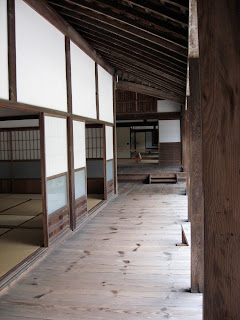The final destination on our journey with Ryan's parents was Hiroshima. Below is the famous building with the domed top that was one of the only structures standing after the atomic bomb dropped.
The A-bomb dome is an important landmark in Hiroshima and can be seen here through the middle of the arched monument in the Peace Memorial Park.
This monument is for a Japanese girl, Sadako Sasaki, who was two years old when the bomb dropped. She survived the blast but years later developed leukemia, likely due to radiation. In the hospital she folded hundreds of origami cranes in hopes of getting better, in reference to a Japanese proverb that promises a wish to anyone who folds a thousand cranes.
She died before reaching her goal of one thousand, but every year Japanese school children from around the country bring cranes to place at her monument. The cranes have become a symbol of peace.
There are tons and tons of paper cranes all over Memorial Park.
And also many school children. Here is a group who were interviewing Ryan's parents for a school project. That is the Memorial museum there in the background.
Since
Himeji castle, which we really wanted to see, is under construction, I was glad to get the opportunity to visit the Hiroshima castle. Although it has been completely rebuilt in recent years and made of concrete, it is rather majestic and hints at its former glory.
It has a moat and outer buildings.
The castle itself is now a museum. You can go all the way to the top for a great view of Hiroshima.
One of the foods that Hiroshima is known for is its Okanomiyaki. Unlike the Tokyo version, theirs is layered. On the bottom is batter like a crepe, then seasonings, cabbage, onions and bean sprouts, pork, then a layer of noodles, a fried egg, some sauce and finally sesame seeds and seaweed powder. Phew! It is so complicated that they don't let you make it yourself. They start making it over behind the counter and bring it out to your table side grill to finish cooking.
Ryan and his parents returned to Tokyo and I stayed on with my boss for a 3-day conference. One of our colleagues took us to his favorite okanomiyaki restaurant.
-------
Only a brief ferry ride away from Hiroshima is the island Miyajima.
Which is home to this famous submerged torii, which appears in every guide book for Japan.
The Miyajima temple is called the floating temple, but it is actually just built on stilts in shallow water, the level of which goes up and down with the tide.
It is a good setting for a wedding.
Miyajima has a lovely 5-story pagoda...
and a population of deer.
For reasons unbeknownst to us, Miyajima is also all about rice spoons. The bigger the better. It is apparently the home of the world's largest rice spoon, below. Why? I really don't know.
One of the Hiroshima/Miyajima specialties is oyster. Here is the oyster extravaganza set meal that Ryan had for lunch one of the days: oysters fried, steamed and baked in a leaf with rice.
And then it was back home via the high speed shinkansen, or bullet train.

















































